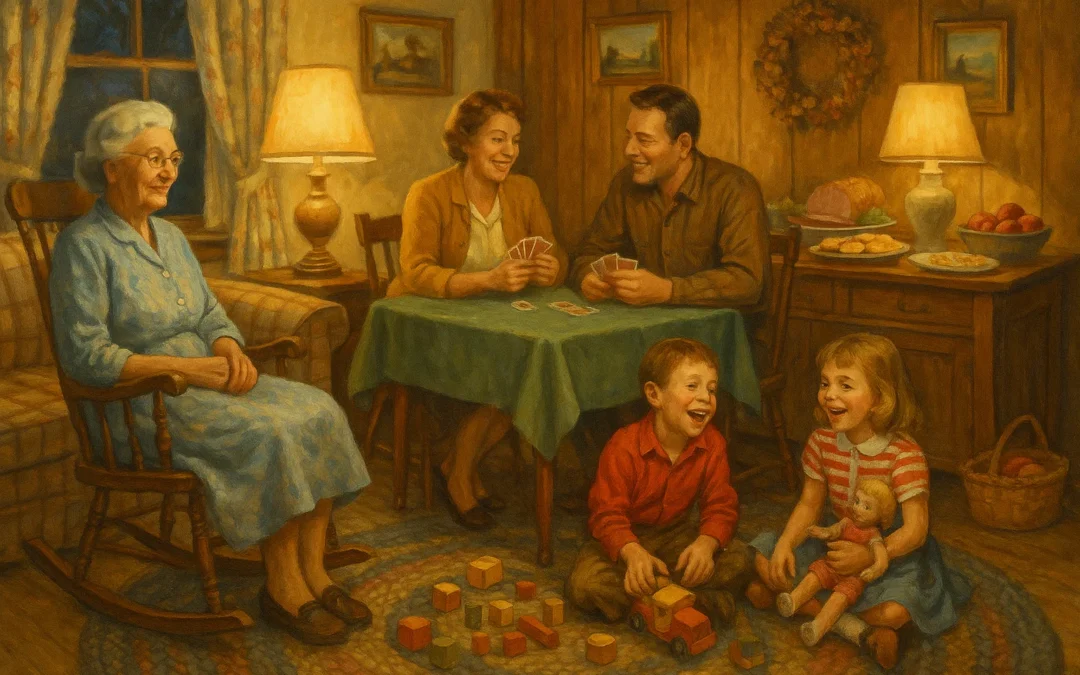The Pull of Family Togetherness
My recent article on family togetherness in an Appalachian family prompted me to see how similar my own family was years ago.
In eastern Kentucky, the Sutherlands — a family of eight adults and their children — pulled together when their grandmother suffered a heart attack. Everyone rallied around to help, not only supporting her but also one another. The family’s strength relied on their rhythm of life, which included family dinners, shared responsibilities, and a closeness that made hard times easier to bear.
That true story brought back memories of my own family roots. My dad used to talk about, while growing up, their weekly visits to “the home place” — my Granny Eva’s house in rural Floyds Knobs, Indiana. It was never quiet there. Cars lined the yard like a small parking lot, and inside the house, voices mingled over card games (especially euchre), laughter, and food. People came and went all afternoon, and the house had a constant hum of activity.
When we moved north to the Chicago area in 1962, those visits ended. We found new friends, of course, but it never felt quite as warm or embracing as those gatherings back home.
Moving for Safety and Opportunity
By the 1960s, migration was reshaping many neighborhoods in the Chicago area. Families were fleeing from the city, often looking for safer streets and better schools. I remember new classmates entering our Catholic grammar school who weren’t even Catholic to avoid forced busing in a nearby suburb.
One friend of mine, from a family of 12, told stories that made it clear why his parents wanted to leave Chicago. He described running into street gangs, ready to pull off his belt to use as a weapon if needed. He even learned to check parked cars for unlocked doors. And then if you were caught by police, they might whack you with rubber hoses so the marks wouldn’t show.
These were eye-opening moments of which my innocent life was unaware. His parents knew they had to move before their kids were drawn too deeply into that kind of trouble.
Usually, these family moves were only a half an hour away. Other times, families left Illinois altogether. In my own family, some moves were prompted by the wives who wanted more independence from in-laws—or maybe just a better job opportunity.
The Desire to Stay Close
Not every family move was met with excitement. I remember when my wife and I considered moving two hours away, my dad urged us to stay closer. He was carrying forward a tradition of family togetherness. While his childhood had been filled with weekly Sunday visits to relatives, he reimagined that practice in his 80s by hosting monthly meals at his condo. He would invite all of us — children and grandchildren — to come together around his table. For him, and for us, those gatherings kept the family bond alive. Now that mom and dad have passed, we continue the tradition with bi-weekly video meetings.
When Neighborhoods Change
Chicago-area neighborhoods were known for turning over quickly. In some cases, whole blocks emptied in just a few years. Real estate agents—plaid suits and all—would knock on doors, warning homeowners that their property values had plummeted in just the last few months. “Ya gotta sell now!” they would say. Of course it was a self-fulfilling prophesy.
Frightened families, often with their retirement savings tied up in their homes, panicked and moved.
At the same time, other families left for jobs, affordability, or simply a change in climate. Sometimes I wonder how I can long endure these frigid winters up north. More recently, many have chosen to move from high-tax states like Illinois, New York, and California to states like Texas and Florida, where costs are lower and, sometimes, political values are more aligned.
Here in Illinois, property taxes have been a sore spot. When we first moved into our home in a suburban/rural area nine years ago, our taxes jumped 23% in one year. So much for escaping Cook County’s high levies. This year, they rose another 19%. Gulp.
Compare that with places like Troy, Michigan, which caps tax increases at just a few percent — helping families stay put, keeping neighborhoods stable, and communities safer.
Coming Full Circle
Even with all the moves people make—whether across town, across state lines, or across the country—many eventually feel the tug of home. As the years pass, memories of childhood friends, family dinners, and familiar places call us back.
For all the reasons people leave — safety, opportunity, affordability, independence — the pull of family remains one of the strongest forces of all. Sometimes we remain expats forever, but in the end, family is often where we circle back in our hearts.
If you like the idea of family togetherness, read the story mentioned above, “When Grandma Went to the Hospital: An Appalachian Story.”
Did you enjoy this article? Why not share it among your friends with the below buttons? Thank you.

